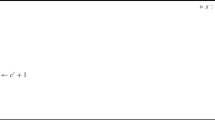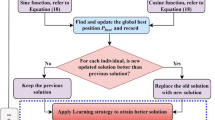Abstract
Enhancing robustness of cyber-physical system under cascading failures still remains to be an important problem. In this paper, we propose a novel coupled model with the process of cascading failure, the DC power flow model and sequential bus/branch recovery in the interdependent power-communication network. Then, we adopt the Q-learning algorithm to search out the optimal recovery sequence with the minimal number of recovery times. By comparing the recovery costs of sequential bus recovery and sequential branch recovery, it is found that the strategy of branch recovery requires less recovery cost. Besides, we have also compared the performance of Q-learning-based branch recovery strategy with those of several other topology-related branch recovery strategies. Experimental results show that the Q-learning-based algorithm can effectively find the optimal sequence of branch recovery.







Similar content being viewed by others
Data availability statement
The data that support the findings of this study are available from the corresponding author upon reasonable request.
References
Gao J, Buldyrev SV, Stanley HE, Havlin S (2012) Networks formed from interdependent networks. Nat Phys 8(1):40–48. https://doi.org/10.1038/nphys2180
Buldyrev SV, Parshani R, Paul G, Stanley HE, Havlin S (2010) Catastrophic cascade of failures in interdependent networks. Nature 464(7291):1025–1028. https://doi.org/10.1038/nature08932
Chen Z, Wu J, Xia Y, Zhang X (2017) Robustness of interdependent power grids and communication networks: A complex network perspective. IEEE Trans Circuits Syst II: Expr Briefs 65(1):115–119. https://doi.org/10.1109/tcsii.2017.2705758
Li F, Yan X, Xie Y, Sang Z, Yuan X (2019) A review of cyber-attack methods in cyber-physical power system.2019 IEEE 8th International Conference on Advanced Power System Automation and Protection (APAP),pp 1335–1339. https://doi.org/10.1109/apap47170.2019.9225126
Rueda DF, Calle E (2017) Using interdependency matrices to mitigate targeted attacks on interdependent networks: A case study involving a power grid and backbone telecommunications networks. Int J Crit Infrastruct Protection 16:3–12. https://doi.org/10.1016/j.ijcip.2016.11.004
Shao J, Buldyrev SV, Havlin S, Stanley HE (2011) Cascade of failures in coupled network systems with multiple support-dependence relations. Phys Rev E 83(3):036116. https://doi.org/10.1103/physreve.83.036116
Huang Z, Wang C, Ruj Ruj, Stojmenovic M, Nayak A (2013) Modeling cascading failures in smart power grid using interdependent complex networks and percolation theory.2013 IEEE 8th Conference on Industrial Electronics and Applications (ICIEA), pp 1023–1028. https://doi.org/10.1109/iciea.2013.6566517
Ji X, Wang B, Liu D, Dong Z, Chen G, Zhu Z, Zhu X, Wang X (2016) Will electrical cyber-physical interdependent networks undergo first-order transition under random attacks? Phys Stat Mech Appl 460:235–245. https://doi.org/10.1016/j.physa.2016.05.017
Sun W, Liu C-C, Zhang L (2010) Optimal generator start-up strategy for bulk power system restoration. IEEE Trans Power Syst 26(3):1357–1366. https://doi.org/10.1109/tpwrs.2010.2089646
Sarmadi SAN, Dobakhshari AS, Azizi S, Ranjbar AM (2011) A sectionalizing method in power system restoration based on wams. IEEE Trans Smart Grid 2(1):190–197. https://doi.org/10.1109/tsg.2011.2105510
Wu J, Fang B, Fang J, Chen X, Chi KT (2019) Sequential topology recovery of complex power systems based on reinforcement learning. Phys Stat Mech Appl 535:122487. https://doi.org/10.1016/j.physa.2019.122487
Zhang Y, Wu J, Chen Z, Huang Y, Zheng Z (2019) Sequential node/link recovery strategy of power grids based on q-learning approach. 2019 IEEE International Symposium on Circuits and Systems(ISCAS), pp 1–5. https://doi.org/10.1109/iscas.2019.8702107
Jia H, Zheng H, Gai Y, Xu D (2019) Network recovery for large-scale failures in smart grid by simulation. International Conference on Simulation Tools and Techniques:477–485. https://doi.org/10.1109/compcomm.2018.8780720
Huang Y, Wu J, Ren W, Chi KT, Zheng Z (2018) Sequential restorations of complex networks after cascading failures. IEEE Trans Syst, Man, Cybern: Syst 51(1):400–411. https://doi.org/10.1109/tsmc.2018.2874822
Gong M, Ma L, Cai Q, Jiao L (2015) Enhancing robustness of coupled networks under targeted recoveries. Sci Rep 5(1):1–7. https://doi.org/10.1038/srep08439
Li J, Li Y, Su Q (2022) Sequential recovery of cyber-physical power systems based on improved q-learning. Journal of the Franklin Institute(accepted). https://doi.org/10.1016/j.jfranklin.2022.05.043
Hines P, Cotilla-Sanchez E, Blumsack S (2010) Do topological models provide good information about vulnerability in electric power networks?PubMed. https://doi.org/10.1063/1.3489887
Gao X, Peng M, Chi KT, Zhan H (2020) A stochastic model of cascading failure dynamics in cyber-physical power systems. IEEE Syst J 14(3):4626–4637. https://doi.org/10.1109/jsyst.2020.2964624
Cai Y, Cao Y, Li Y, Huang T, Zhou B (2015) Cascading failure analysis considering interaction between power grids and communication networks. IEEE Trans Smart Grid 7(1):530–538. https://doi.org/10.1109/tsg.2015.2478888
Sydney A, Scoglio C, Youssef M, Schumm P (2010) Characterising the robustness of complex networks. Int J Internet Technol Secur Trans 2(3–4):291–320. https://doi.org/10.1504/ijitst.2010.037406
Borgatti SP, Everett MG (2006) A graph-theoretic perspective on centrality. Soc Netw 28(4):466–484. https://doi.org/10.1016/j.socnet.2005.11.005
Wu J, Chi KT, Lau FC (2015) Concept of node usage probability from complex networks and its applications to communication network design. IEEE Trans Circuits Syst I: Regular Papers 62(4):1195–1204. https://doi.org/10.1109/tcsi.2015.2399024
Sridhar S, Hahn A, Govindarasu M (2011) Cyber-physical system security for the electric power grid. Proc IEEE 100(1):210–224. https://doi.org/10.1049/pbpo081e_ch16
Kim Y, Bae JN, Jin YK (2011) Performance of power line communication systems with noise reduction scheme for smart grid applications. IEEE Trans Consumer Electron 57(1):46–52. https://doi.org/10.1109/tce.2011.5735480
Tang H, Lv K, Bak-Jensen B, Pillai JR, Wang Z (2022) Deep neural network-based hierarchical learning method for dispatch control of multiregional power grid. Neural Comput Appl 34(7):5063–5079. https://doi.org/10.1007/s00521-021-06008-4
Wan Z, Li J, Gao Y (2018) Monitoring and diagnosis process of abnormal consumption on smart power grid. Neural Comput Appl 30(1):21–28. https://doi.org/10.1007/s00521-016-2719-4
Villa D, Martin C, Villanueva FJ, Moya F, López JC (2011) A dynamically reconfigurable architecture for smart grids. IEEE Trans Consumer Electron 57(2):411–419. https://doi.org/10.1109/tce.2011.5955174
Gupta S, Kambli R, Wagh S, Kazi F (2014) Support-vector-machine-based proactive cascade prediction in smart grid using probabilistic framework. IEEE Trans Industr Electron 62(4):2478–2486. https://doi.org/10.1109/tie.2014.2361493
Motter AE (2004) Cascade control and defense in complex networks. Phys Rev Lett 93(9):098701. https://doi.org/10.1103/physrevlett.93.098701
Eppstein MJ, Hines PD (2012) A ‘random chemistry’ algorithm for identifying collections of multiple contingencies that initiate cascading failure. IEEE Trans Power Syst 27(3):1698–1705. https://doi.org/10.1109/pesmg.2013.6672899
Stott B, Jardim J, Alsaç O (2009) Dc power flow revisited. IEEE Trans Power Syst 24(3):1290–1300. https://doi.org/10.1109/tpwrs.2009.2021235
Huang W, Zhang T, Yao X (2022) Optimization for sequential communication line attack in interdependent power-communication network. Phys Stat Mech Appl 59:126837. https://doi.org/10.1016/j.physa.2021.126837
Sutton RS, Barto AG (1998) Reinforcement learning: an introduction. MIT Press, Cambridge. https://doi.org/10.1007/978-1-4615-3618-5_1
Watkins CJ, Dayan P (1992) Q-learning. Mach Learn 8(3):279–292
Chawla A, Agrawal P, Panigrahi BK, Paul K (2021) Deep-learningbased data-manipulation attack resilient supervisory backup protection of transmission lines. Neural Comput Appl 4:1–20. https://doi.org/10.1007/s00521-021-06106-3
Li H, Wang L, Sun Z, Wang X (2019) Interdependent network cascading failure analysis based on load distribution and node backup strategy.2019 Chinese Control Conference (CCC), pp 5214–5219. https://doi.org/10.23919/chicc.2019.8866543
Acknowledgments
This work was supported by National Key R &D Program of China (2022YFE0198900), National Natural Science Foundation of China (61771430) and Basic Public Welfare Research Project of Zhejiang Province in China (LGG18F030002).
Author information
Authors and Affiliations
Corresponding author
Ethics declarations
Conflict of interest
The authors declare that there is no conflict of interest.
Additional information
Publisher's Note
Springer Nature remains neutral with regard to jurisdictional claims in published maps and institutional affiliations.
Rights and permissions
Springer Nature or its licensor (e.g. a society or other partner) holds exclusive rights to this article under a publishing agreement with the author(s) or other rightsholder(s); author self-archiving of the accepted manuscript version of this article is solely governed by the terms of such publishing agreement and applicable law.
About this article
Cite this article
Huang, W., Gao, Y., Zhang, T. et al. Q-learning-based sequential recovery of interdependent power-communication network after cascading failures. Neural Comput & Applic 35, 12833–12845 (2023). https://doi.org/10.1007/s00521-023-08399-y
Received:
Accepted:
Published:
Issue Date:
DOI: https://doi.org/10.1007/s00521-023-08399-y




